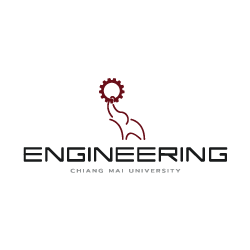การวิเคราะห์ความสามารถในการผสมของถังกวนผสม โดยใช้พลศาสตร์ของไหลเชิงคำนวณ
คำสำคัญ:
เครื่องปฏิกรณ์แบบถังกวน, พลศาสตร์ของไหลเชิงคำนวณ, แบบจำลองความปั่นป่วน, การผสมบทคัดย่อ
เครื่องปฏิกรณ์แบบถังกวนเป็นอุปกรณ์ที่ใช้กันอย่างแพร่หลายในทางอุตสาหกรรม การเข้าใจถึงลักษณะการไหลภายในถังเป็นสิ่งสำคัญในการกำหนดประสิทธิภาพการทำงานของกระบวนการกวนผสม วัตถุประสงค์ของบทความคือการศึกษาลักษณะการไหลและการกระจายความเร็วของของไหลภายในเครื่องปฏิกรณ์แบบถังกวนที่ใช้ใบพัดแบบ Rushton จำนวน 8 ใบพัด ที่ตำแหน่งกึ่งกลางถังในการผลักดัน คำนวณผลการไหลด้วยพลศาสตร์ของไหลเชิงคำนวณ โดยใช้แบบจำลองความปั่นป่วนแบบการไหลวนขนาดใหญ่ และใช้เทคนิคกริดเลื่อน ในการจำลองการเคลื่อนที่ของใบพัด ศึกษาลักษณะการไหลที่ความเร็วรอบใบพัด 100, 200 และ 300 rpm ผลการทดสอบพบว่าความเร็วในแนวสัมผัสสร้างกระแสหมุนวนรอบแกนเพลาภายในถังกวนผสมอย่างชัดเจน เมื่อทำการกวนผสมอย่างต่อเนื่องจะพบว่าลักษณะการไหลจะเข้าสู่สภาวะคงตัว ลักษณะการไหลนี้จะส่งผลถึงความสามารถในการกวนผสมที่ต้องการความปั่นป่วนในการส่งผ่านมวลระหว่างของไหล แต่การสร้างความปั่นป่วนจำเป็นต้องใช้พลังงานสูงในการคงสภาพ
เอกสารอ้างอิง
Sbrizzai, F., Lavezzo, V., Verzicco, R., Campolo, M. and Soldati, A. Direct Numerical Simulation of Turbulent Particle Dispersion in an Unbaffled Stirred-Tank Reactor. Chemical Engineering Science, 2006; 61(9):2843-2851.
Gimbun,J.,Rielly, C.D., Nagy, Z.K. and Derksen, J. J. Detached Eddy Simulation on the Turbulent Flow in A Stirred Tank. AIChE Journal, 2012; 58(10):3224–3241.
Derksen, J. Long-Time Solids Suspension Simulations by means of a Large-Eddy Approach. Chemical Engineering Research and Design, 2006; 84(1):38–46.
Li, Z.,Hu, M.,Bao, Y. and Gao, Z. Particle Image Velocimetry Experiments and Large Eddy Simulations of Merging Flow Characteristics in Dual Rushton Turbine Stirred Tanks. Industrial and Engineering Chemistry Research, 2012; 51(5): 2438–2450.
Gillissen,J. J. and Van den Akker,H. E. Direct Numerical Simulation of the Turbulent Flow in a Baffled Tank Driven by a Rushton Turbine. AIChE Journal, 2012; 58(12):3878–3890.
Talaga,J. and Fort, I. The Velocity Field in the Discharge Stream from a Rushton Turbine Impeller. The 14th European Conference on Mixing. September 10, Warszava, Poland, 2012.
Venneker, B.C.,Derksen, J.J. and Van den Akker, H.E.A. Turbulent Flow of Shear-Thinning Liquids in Stirred Tanks-the Effects of Reynolds Number and Flow Index. Chemical Engineering Research and Design, 2010; 88(7):827–843.
Versteeg,H.K. and Malalasekera,W. An Introduction to Computational Fluid Dynamics.2ndEdition, John Wiley & Sons, New York, 2007.
Kundu,P. Cohen, I. and Dowling, D. Fluid Mechanics.5th Edition, Elsevier, UK, 2012.
Rojanaratanangkule, W. Advanced Theories in Fluid Mechanics. Department of Mechanical Engineering, Chiang Mai University, 2016.
Paul, E.L., Atiemo‐Obeng, V.A. and Kresta, S.M. Handbook of Industrial Mixing: Science and Practice. John Wiley & Sons, 2004.
Verzicco, R., Iaccarino, G., Fatica, M. and Orland, P. Flow in an Impeller Stirred Tank Using an Immersed‐Boundary Method. AIChE journal,2004; 50(6): 1109-1118.
Christopher J. Open Foam User Guide, V5.0. Open FOAM Foundation Ltd., 2017.
Murthy, J. Y., Mathur, S. R., and Choudhary, D. CFD Simulation of Flows in Stirred Tank Rectors Using a Sliding Mesh Technique. 8th Europe Conference on Mixing, September 21-23, Cambridge, UK, 1994; 155-162.
Joshi, J.B., Nere, N.K., Rane, C.V., Murthy, B.N., Mathpati, C.S., Patwardhan, A.W. and Ranade, V.V. CFD Simulation of Stirred Tanks: Comparison of Turbulence Models. Part I: Radial Flow Impellers. Canadian Journal of Chemical Engineering, 2011; 89(1):23-82.
Joshi, J.B., Nere, N.K., Rane, C.V., Murthy, B.N., Mathpati, C,S., Patwardhan, A.W. and Ranade, V.V. CFD Simulation of Stirred Tanks: Comparison of Turbulence Models(Part II: Axial Flow Impellers, Multiple Impellers and Multiphase Dispersions). Canadian Journal of Chemical Engineering, 2011; 89(4):754-816.
ANSYS FLUENT theory guide: Release 16.2. ANSYS, Canonsburg, Pennsylvania (2013).
Huang, W., and Li, K. CFD Simulation of Flows in Stirred Tank Reactors Through Prediction of Momentum Source. Nuclear Reactor Thermal Hydraulics and Other Applications, 2013: 135-153.
Kysela, B., Konfrst, J., Fort, I. and Chara, Z. CFD Simulation of the Discharge Flow from Standard Rushton Impeller. International Journal of Chemical Engineering, 2014; 706149: 1-7.
Chara, Z., Kysela, B., Konfrst, J. and Fort, I. Study of Fluid Flow in Baffled Vessels Stirred by a Rushton Standard Impeller. Applied Mathematics and Computation,2016; 272(3): 614-628.
ดาวน์โหลด
เผยแพร่แล้ว
ฉบับ
ประเภทบทความ
สัญญาอนุญาต
ลิขสิทธิ์ของบทความที่ตีพิมพ์ในวารสารฉบับนี้จะยังเป็นของผู้แต่งและยินยอมให้สิทธิ์เผยแพร่กับทางวารสาร
การเผยแพร่ในระบบวารสารแบบเปิดนี้ บทความจะสามารถนำไปใช้ได้ฟรีในการศึกษา และในทางที่ไม่เกี่ยวกับการค้า




